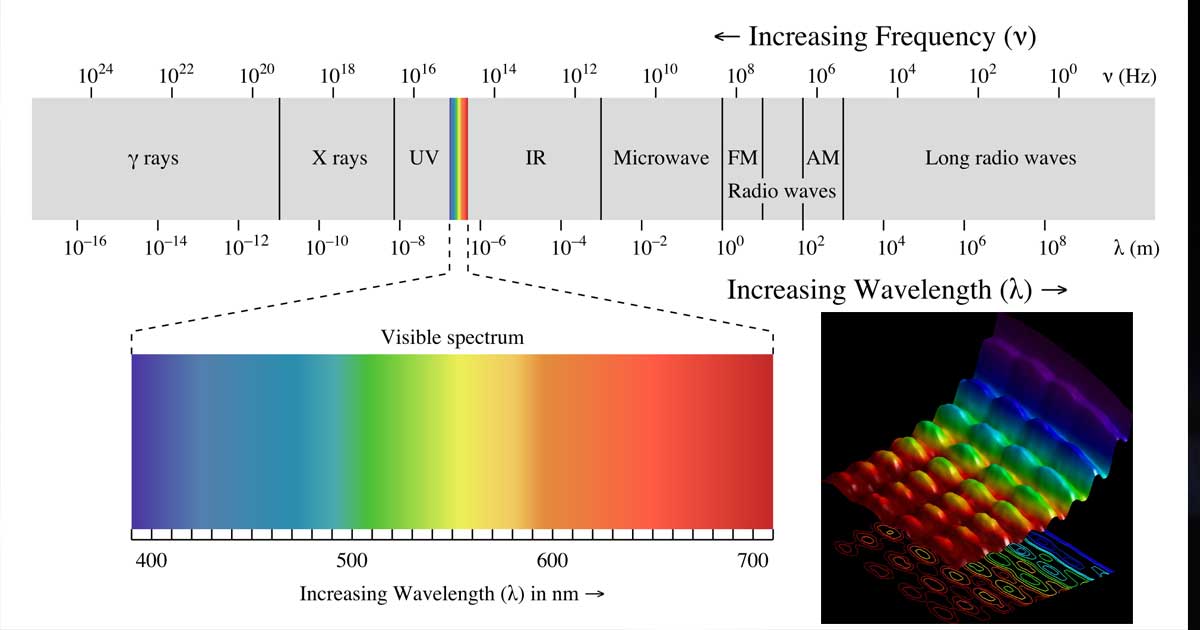Visible Light is “a thin strand” of electromagnetic radiation. A specific range of frequencies of vibration within the overarching electromagnetic field.
Visible Light is Electromagnetic Radiation fact

What is Visible Light?
Visible light is a range of wavelengths in the electromagnetic spectrum visible to the human eye (wavelengths of about 390 to 700 nm).
What Is Light? Want to know more about light? See our “what is light page.”What is Visible Light – Technical Answer
Visible light is a wave of electromagnetic radiation, or rather, a photon acting as a wave. It vibrates within a specific range of frequencies in the electromagnetic field. The electromagnetic field fills space and contains localized vibrations that we call photons. See wave-particle duality and quantum field theory.[1][2]
Each color of light is related to a different set of frequencies, and visible light is only a tiny portion of the whole spectrum.
When we look at an object, the colors we see are specific wavelengths reflected off that object. So a red ball absorbs every color but red; it reflects a certain frequency of waves that we interpret as red using our sense of sight.
Light – Bozeman ScienceUnderstanding the Photon, Electromagnetic Radiation, and the Electromagnetic Spectrum
Before discussing electromagnetic radiation further, we need to recognize that there are many ways to describe phenomena related to electromagnetic force (one of four forces, of which the photon is the carrier particle). Descriptions of electromagnetic radiation include light, photon, electromagnetic waves, a vibration in the electromagnetic field, electromagnetic energy, visible light, X-rays, Gamma-rays, Radio waves, infrared, ultraviolet, etc.
Both the photon and the radiation it emits are vibrations in the electromagnetic field, i.e. photons which act as both particles and waves.
Light: Crash Course Astronomy #24What is Electromagnetic Radiation?
Electromagnetic radiation is a way to describe the electromagnetic energy that radiates away from other electromagnetic energy. When that radiation is in a particular range of wavelengths, our eyes can see it, and we call it visible light.
Understanding Visible Spectrum and Electromagnetic Radiation
Visible light is composed of a small range of frequencies that are visible to the human eye. Other possible frequencies of electromagnetic energy, which we call the electromagnetic spectrum, are outside our visible limits.
The spectrum represents the possibilities of wavelengths between the smallest and the largest distance between crests in a wave possible, as well as the minimum and maximum energy content of a localized charge in the electromagnetic field (aka a photon).
Light Absorption, Reflection, and Transmission – Bozeman ScienceUnderstanding the Different Frequencies of the Electromagnetic Spectrum
“Radiation from electromagnetic force” (electromagnetic radiation) is described by Planck’s equation E=hf, where E is the energy per photon, f is the frequency of the photon, and h is Planck’s constant.
Electromagnetic radiation comes in a broad range of “sizes.” A single gamma ray photon, for example, might carry ~100,000 times the energy of a single photon of visible light.
Photons can emit or absorb other photons. When this happens, the energy content changes. Some photons emitted with the right energy content are detectable as visible light.
Emission and Absorption Spectra – Bozeman Science. This video describes the emission and absorption of photons and how that relates to visible light.TIP: Light is both a particle and a wave, learn more about the true nature of light.
TIP: Each color of light has a unique frequency. White light describes light that has all the colors in it; colored light can be separated from white light in a prism.

Watch Richard Feynman explain radiation (and much more) below. This is an outstanding lecture series.
QED: Photons — Corpuscles of Light — Richard Feynman (1/4). You know, back before the internet, you couldn’t just sit down with Richard Feynman and get a lecture on QED without enrolling in a theoretical physics course at Caltech. Today, with all our mastery of mass-energy and physics, we have YouTube. NOTE: Feynman as in the Feynman diagrams that model quantum theory.
mythbuster3574 Doesn't beleive this myth.
how can light be electrtoMAGNETIC radation?? i cant attract lights with the magnet i got from the scholastic bookfair????
Thomas DeMicheleThe Author Did not vote.
Get a better magnet.
😀
Jokes aside, electricity and magnetism are different manifestations of the same force / field (electromagnetic force / field). Meanwhile, visible light is the “radiation” of that force, meaning it is that force in the form form of light (photons). While you can’t catch photons with a magnet, they can interact (attract / repel) with other electromagnetic particles and that interaction is an electromagnetic one. So, in short, get a better magnet.